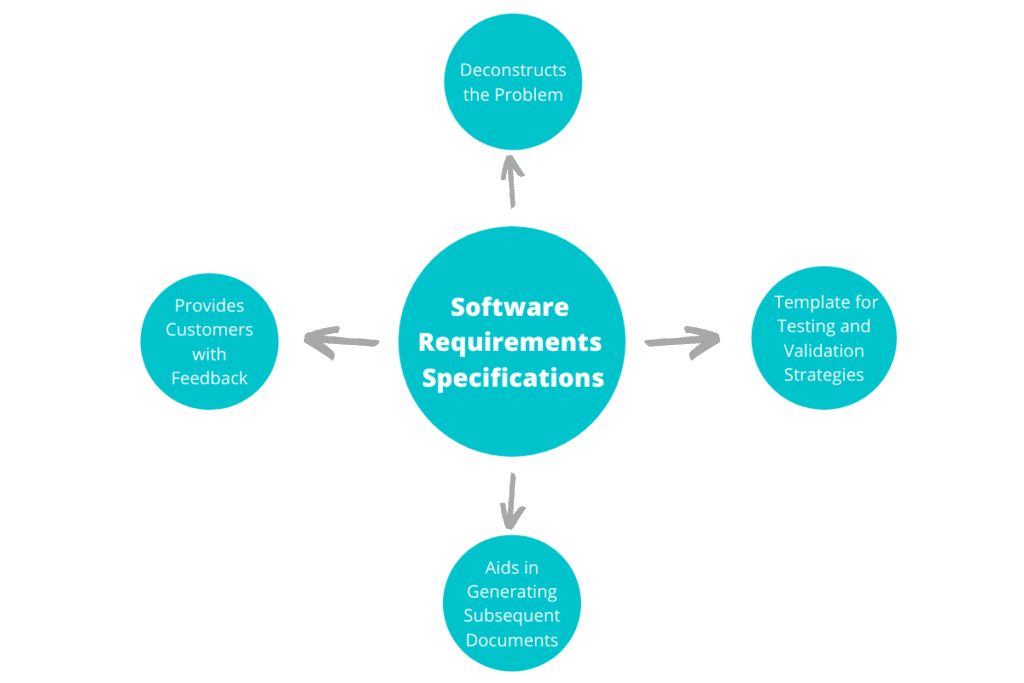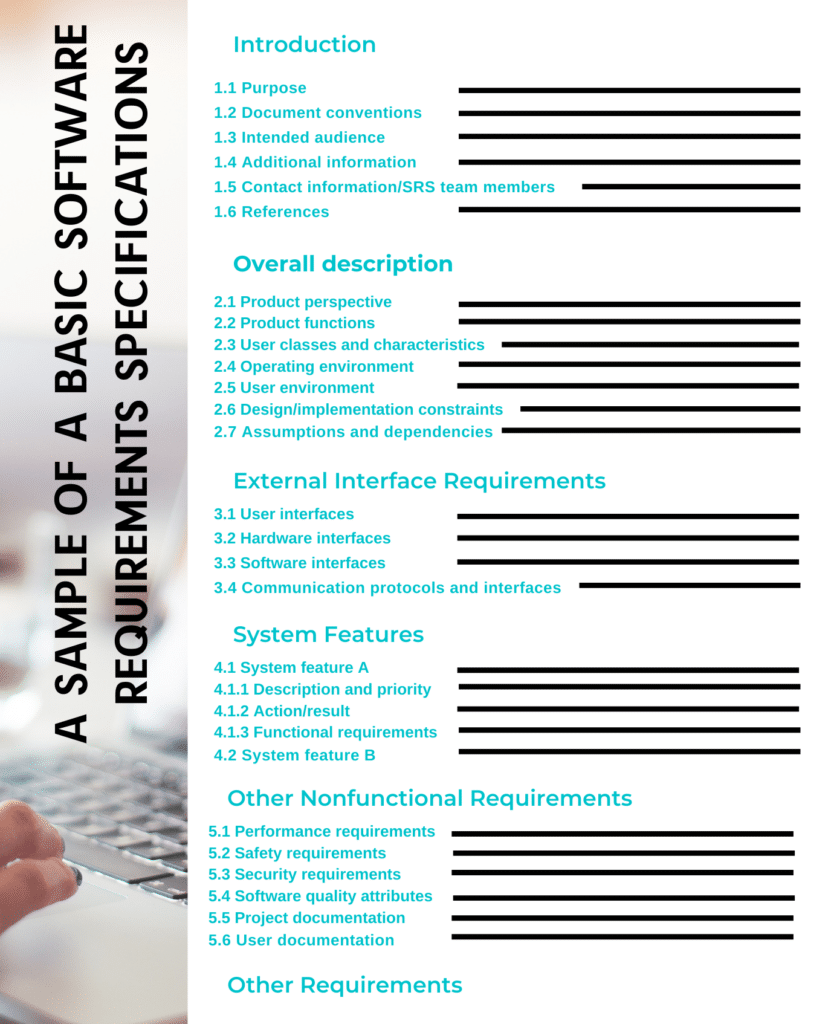How to Write Software Requirements Specifications
October 22nd, 2020
In this article, we’ll describe what the software requirements specifications (SRS) document is and why it is extremely important for the software development process. We’ll also discuss how to write software requirements specifications step by step, as well as some rare but still important elements to take into account.
While this article will by no means be comprehensive, it will help you determine how to approach such a project and provide you with valuable guidelines for writing an effective SRS.
Software Requirements Specifications: An Overview
Put simply: an SRS is a company’s written representation of their potential client or customer’s system requirements/dependencies at any given point in time. Most often, this is the period before any design or development work begins. It basically functions as an insurance policy for both parties, ensuring that both the company and the client are on the same page regarding requirements.
The document itself uses explicit and exact language to state the capabilities and functions of a software system, application, eCommerce website, etc. and lists any limitations that need to be put on the system from the start. At the same time, the Software Requirements Specifications functions as an outline for how the project can be completed with minimal cost growth.
In many cases, companies will refer to the SRS as the “parent” document, as all subsequent documents related to project management (design specs, software architecture specs, statements of work, etc.) will fall under its purview. Software Requirements Specifications documents contain both functional and non-functional requirements, but don’t offer suggestions related to design, technology issues, etc.
An SRS is only intended to represent the development team’s understanding of the client’s system requirements. Well-written Software Requirements Specifications achieves four things:
1. It Provides Customers with Feedback
An SRS is a contract that assures the customer that the developing company comprehends their needs. Rather than use formal language or “legalese,” it’s important that an SRS use natural language that clearly states the problems and solutions involved. In some cases, the use of charts, tables, and diagrams can help immensely.
2. It Deconstructs the Problem
In most situations, simply writing down software requirements will help organize them into sections or parts. By deconstructing the greater problem into easily-digestible segments, it creates a more orderly “plan of attack.”
3. It Aids in Generating Subsequent Documents
As we mentioned, the Software Requirements Specifications is designed to be a parent document that guides the creation of software design specs, statement of work docs, etc. For this reason, it’s important that the SRS be detailed enough to outline the functional system requirements effectively.
4. It Serves as a Template for Testing and Validation Strategies
The SRS is most often developed in the early stages of “Requirements Development.” This is the first page of product development and involves information gathering utilizing surveys, questionnaires, onsite visits, analysis of the marketplace, and more.

What to Include in a Successful Software Requirements Specifications
The development of an SRS is most often a collaborative effort, with many team members working together in concert. If the company has already developed successful Software Requirements Specifications documents in the past, there will hopefully be examples to view. However, assuming the organization is starting completely from scratch, there are nine specific topics that should be addressed before the SRS can be called complete.
- Interfaces
- Functional Capabilities
- Performance Levels
- Data Structures/Elements
- Safety
- Reliability
- Security/Privacy
- Quality
- Constraints and Limitations
These could be considered the “ingredients” for the overall document, but they aren’t merely static. They need to be interwoven into the document in four specific sections:
- The template
- The method for identifying requirements / linking sources
- The rules business operation
- The traceability matrix
An Effective SRS Template
The first and most important step in writing a Software Requirements Specifications is to find a pre-existing template that the company can restructure to fit their needs. While there’s no standardized version of such a template (as individual requirements will always be unique), there are enough effective examples out there that a company can use to get started. After that, they can customize it as they need to.

While templates are important, it’s crucial not to merely copy a template and use it as your own. Instead, let those SRS examples function as guides so that you can ensure you include all the important elements. You’re simply seeing what someone else has written, then tailoring it to fit your specific project.
Though Google Docs and Microsoft Word are the go-to programs for written content, it’s worth considering a requirements management software (providing the company has the budget and the project has the time). These are programs specifically-designed for Software Requirements Specifications management and often include tools to track, analyze, test, visualize, etc. Examples include:
- Requirements Hub – Requirements Hub offers 100 pre-built templates that you can use to design your SRS. You can also develop one from scratch if you prefer. Overall, this program helps save you money and time by allowing you to effectively gather and produce requirement data.
- Jira Software – Jira is by far the most popular software in the Software Requirements Specifications realm. It is versatile, effective, and relatively easy to use, allowing you to configure your requirements while also testing case traceability processes. In general, Jira functions as a project management tool, but it also features a wide range of collaboration tools to keep all parties informed of the process.
- Blueprint – Blueprint allows you to store and organize all of the artifacts related to the project. This helps teams create documents while providing traceability and impact analysis to product managers. With this level of transparency, teams are able to work faster and collaborate more easily.
Identify Requirements with Sources
As we said earlier, Software Requirements Specifications are used to establish both the functional and non-functional requirements of a product. In the case of functional requirements, each has an origin, including use cases, government regulations, business requirements, industry standards, etc. When you develop your SRS, you need to identify these origins and ensure they are linking to their associated requirements. This doesn’t just explain the requirement, but it helps eliminate any requirements that stakeholders might consider frivolous.
To link requirements and sources, simply include a specific label that will remain constant throughout the project, even as requirements are changed, added, or removed. This labeling system will make for fewer headaches later when it comes time to gather metrics, etc. To get started, simply develop a separate list that associates each requirement ID with the proper description. Eventually, these links will become an integral part of the SRS itself.
The Elements of the Perfect Software Requirements Specifications
There are characteristics that every Software Requirements Specifications should feature. That’s why we’ve assembled this checklist that you can use after your SRS is completed. Include all of these elements, and you can be confident that your SRS will do the job it needs to do.
| Component | Explanation | |||
| Consistent | SRS capacity functions and operation stages are consistent, and the necessary quality characteristics do not nullify those capacity functions. | |||
| Accurate | SRS exactly specifies the system’s capacity in the real-world, and how it connects and engages with it. This part of the requirements is a major issue for many SRSs. | |||
| Ranked | Specific conditions of an SRS are hierarchically ordered according to permanence, protection, ease/difficulty of performance, or other parameters that help in the design. | |||
| Complete | SRS determines exactly all the go-live cases that will be faced and the system’s ability to effectively handle them. | |||
| Modifiable | The rational, hierarchical design of the SRS has to ease any required adjustment (combine relevant matters together and split up them from irrelevant issues makes the SRS simpler to change). | |||
| Testable | An SRS has to be specified that unequivocal and clear evaluation requirements can be taken from the SRS without any mediators. | |||
| Valid | A valid SRS it’s when all participants could figure out, study, admit, or approve it. |
There’s much more we can say about the specifications and process overall. I hope, this article will help you begin if you just set up your development team.








